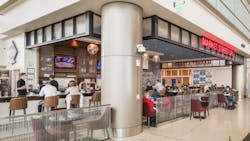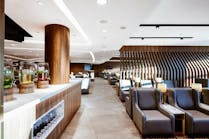When Salt Lake City Department of Airports Commercial Manager Brad Wolfe began thinking about the new concessions program inside the planned new terminal at Salt Lake City International Airport (SLC) a decade ago, there was an opportunity to build an efficient and convenient program.
Airport leaders sat down and thought about the elements of building a supreme concessions program using a blank slate and how it would fit into the future of the facility. They brought in consultants and guided it through to completion in September 2020.
SLC is seeing its efforts pay off in the terminal and in the industry as it won the 2022 Richard A. Griesbach Award of Excellence from Airports Council International-North America (ACI-NA).
“It’s really an award of everyone being able to work together to make something really neat happen,” Wolfe said. “It’s about the designs, the architects, our program management team that put that put the facilities together and made it work for the concessionaires.
“It’s a collective effort and it feels really good to be a part of that. We’re taking care of the customer really well and it’s a result of us all working together.
Designed for Efficiency
The concession program at SLC was designed to elevate the passenger experience in an efficient operating environment for the concessionaires, including carefully designed back-of-house access, lower-level support space and a centralized receiving and delivery center.
Goals for the program included:
· Thoughtful placement and layout of concessions in relation to passenger congregation points and along circulation routes for connecting passengers
· Variety of restaurants and shops catering to a mix of tastes, price points and dietary restrictions
· Inclusion of concessionaires with the ability to pivot to meet evolving needs
· Adherence to a street-pricing policy
· Upgraded amenities, including a greeting room and strong pre-security concession program
· A mix of strong local and national brands, including a LEGO Store
· Concession products and menus supporting a sustainable future
· Concessions built with a focus on sustainability
Airport management conducted a competitive process to engage a team of designers and commercial planners, including HOK and AirProjects, to program, plan and design the new commercial program.
HOK worked on the design to ensure the right square footage in the right places. The airport leadership team looked at ways to create more operating efficiencies through back-of-house service, corridors, close proximity storage units, trash compactors and delivery docks.
SLC created a Central Receiving Distribution Center (CRDC) designed for goods delivery access. The new setup allows concessionaires to cut trash runs by upwards of 30 minutes compared to the old terminal.
All concessions are located no more than 300 feet apart. Some restaurants can access an elevator directly behind their facility and take it right to their storage facility.
“There's only one food and beverage location in our airport that has in-store grease interceptor,” said SLC Director of Administration & Commercial Services Shane Andreasen. “Everything else goes out to the ramp in large tanks and it's clean. It's very efficient because the concessionaire doesn't have to touch it, they have to connect to our system and then we take care of the rest.”
An aggressive recycling program was put into place for concessionaires. Energy Star-rated equipment was installed and recycled materials were used to build facilities.
Sustainable building and design practices were incorporated into the Tenant Design Standards and concessionaires were encouraged to adopt business practices to work with their concepts.
Concessionaires were encouraged to commit to inclusion of organic and locally sourced agricultural products from the region, sustainably sourced seafood, organic or all-natural meat and the use of compostable take away containers and utensils.
Local and National Offerings Together
Extensive local and national outreach, and pre-proposal conferences, were conducted to ensure concession opportunities were widely publicized and attracted the best operators and concepts.
Business terms for the concession opportunities were confirmed through feasibility tests to ensure they create great opportunities for the passengers, concessionaires and the city.
“I think the airport is kind of a big mystery and every once while you know someone will come through and they ‘think Oh my restaurant will do well here, my store would do really well here. How do we get in?’ So we go through an education process before we publish an RFP to make sure that we do the best job we can to get the word out on how the process works and the process is coming,” Wolfe said.
The inclusion of a variety of shops and restaurants with broad customer appeal is key to the program. Restaurants were required to offer menu items addressing dietary restrictions and those with bars were required to have a full bar.
All passengers have a choice of high-quality dining and shopping options with diverse products and varied price points. Retail shops couldn’t be single-gender focused and were required to offer a mix of products at various price points.
SLC provides a world-class shopping experience by providing a diverse mix of local and national brands from Hip & Humble to Coach, offering local products, gifts, jewelry, apparel, accessories, cosmetics, toys, and tech products at various price points.
Salt Lake City favorites like Gourmandise Diner, White Horse Spirits and Kitchen, and Squatters are thriving in their new airport locations beside national brands like Shake Shack, Panera Bread, Smashburger and Garbanzo.
“We wanted a nice balanced mix of local, regional, national brands and then we tried to do our best to hold to that, “Wolfe said. “It has worked out really well. We we've got some good and meaningful local participation.”
Since the full complement of stores and restaurants opened, sales per enplanement exceed $10.50 and sales per square foot average $1,910. Convenience retail generated over $2,890 per square foot and food service generated $2,050 per square foot.
“People are spending on average 20% more than they did in the old airport with fewer concessions open and fewer passengers coming through the airport, Andreasen said. “I think that speaks volumes to the success of just the overall layout, the design, the thought that went into designing it, then also picking the right concepts.”
Prepared for Success
SLC was proactive in helping its concessions partners when the airport terminal opened in the middle of the pandemic. The airport offered about $40 million in low-interest loans to food, retail and rental car tenants.
The airport were charging percentage rent only until SLC hit three consecutive months of 90% of its 2019 enplanements for 3 consecutive months. Then both terms and minimum annual guarantees kicked in.
“We were very pro-concessionaire and wanted to make sure they had everything they needed and we were fair, knowing that nobody expected the pandemic to occur and why should the airport reinforce a lease that was signed three years ago,” Andreasen said.
SLC will bring Phase 2 onboard in November with more quick food options. Phase 3 is planned for fall of 2024 with a potential Phase 4 to follow. Airport leaders plan to use these expansions as an opportunity to build on success going forward.
“The fact that we have really three more phases of construction, three more opportunities means that over the next five years we’ll be able to look back and say, OK, what are the passenger saying now, what do we need to tweak in this next phase to continue to just evolve our program,” Andreasen said.




